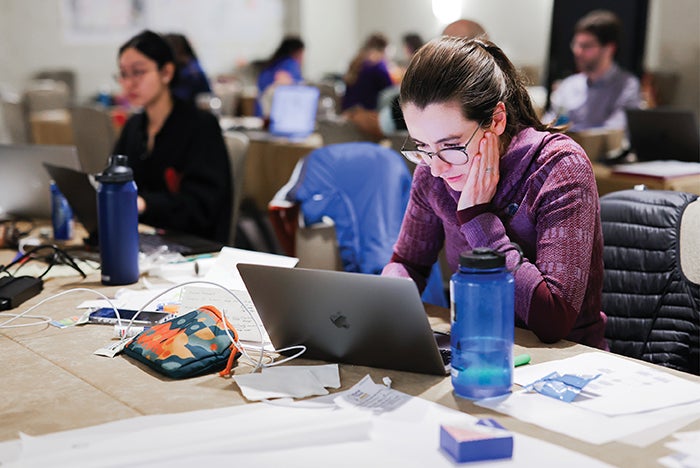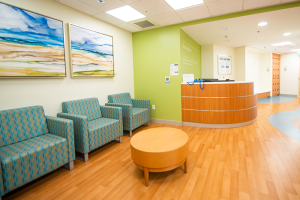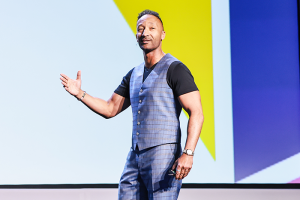Student competition addresses global issue through local lens

Hannah Thorson (foreground), who now has a master’s degree in nursing, helped develop the nursing program that would guide her team’s urgent care facility design.
Image courtesy of ASHE
San Diego, like much of the U.S., is dealing with an affordability crisis. According to U.S. News & World Report, the Southern California coastal city ranked No. 1 as the most expensive U.S. city to live in for 2023 and 2024. However, urban centers with vacant commercial lots create an opportunity to convert empty spaces into affordable residences, and where there are people, care is always needed.
This is the scenario that was presented to 20 students from five universities at the 2024 International Summit & Exhibition on Health Facility Planning, Design & Construction (PDC Summit), which took place in San Diego in March. These students were participants in the annual PDC Student Design Challenge — a multidisciplinary, 48-hour charrette competition in which students receive a prompt, break into teams and develop viable designs answering the prompt’s challenge.
Participants included engineering students from the Milwaukee School of Engineering; construction management students from the University of Washington College of Built Environments; architectural students from the University of Florida College of Design, Construction and Planning and Clemson University School of Architecture; and nursing students from the Montana State University Mark and Robyn Jones College of Nursing.
Imagining a future in which San Diego’s downtown population would increase with the onset of more affordable housing, this year’s students were tasked with converting a vacant commercial space in the city’s urban core into an express urgent care facility focused on providing same-day medical care for minor health care needs, including illness and injury care, on-site testing, and wellness and preventive services.
“San Diego has a lot of health factors, and we were able to give the students [San Diego’s] Community Health Assessment report and really focus in on some of those, like extreme high cost of living, homelessness, a dense urban core with vacancies and safety in the city,” says Leah Meer, AIA, a Health Planner at architecture firm HDR and co-chair of the PDC Student Design Challenge. “I think the prompt was perfect. Every year we create a local challenge, but it’s also addressing a global issue that needs to be solved.”
Gabriel Auffant, AIA, NCARB, LEED AP BD + C, client leader and project manager at RLF Architecture, who also served as chair of this year’s challenge, says the students attacked the problem with aplomb.
“The students really embraced it and did a fantastic job,” he says. “They also brought a new way of communicating their designs to the jury. Each team created unique personas for the different individuals that might come in and use services at the urgent care facility. I think the personas they created were very tangible, and it brought a bit of an emotional component into how they were going to take care of the needs of the community there in San Diego.”
For instance, Team 4, which took home this year’s crown, created profiles for imagined patients like “Ms. B,” a single, 34-year-old Asian mother of two children who could leverage translating services available at the clinic while receiving care as her children used the outdoor play space. Ms. B’s persona picked up on the fact that 37.5% of San Diego’s households are headed by single parents and that 29% of its residents speak a non-English language at home.
Team 2, the challenge’s runner-up, also created care scenarios to address a diversity of clinical needs, such as a patient with bariatric needs who could be cared for with dignity in rooms equipped with a bed and ceiling lift along with various sizes of equipment. The team even created a staff member persona, knowing that health care workers are vulnerable to burnout and would need a space designed with their wellness in mind.
Hannah Thorson, a graduate student who completed the master’s nursing program at Montana State University in May, served as the client for Team 2, bringing a vital clinical perspective to the team’s design, engineering and construction plans. Their facility was planned around the team nursing model, which focuses on assigning nursing staff to a team in which each nurse performs specific duties appropriate to their role for a shared group of patients. Having worked as an emergency department nurse, Thorson says this model helps to protect against isolation.
“There’s a feeling that you have the support of your peers, your providers, your technicians and other nurses behind you to really make the job more satisfying,” she says. “I think it also helps a lot with staff retention.
“We also wanted to incorporate some element of staff wellness into our space,” Thorson continues. “In our design, we have a lot of big windows where staff spaces are placed next to. There’s a staff breakroom, private staff garden and big areas that allow a lot of natural light in.”
Thorson says the experience left her with a greater appreciation for the expertise of those on the planning, design and construction side. One of the students on their team tracked San Diego’s solar patterns in a calendar year to angle the windows in a way that would allow the most natural light.
Throughout the competition, mentors provided valuable feedback about how to use the space, especially outdoor space surrounding the facility. Team 2 created a tiered garden that could serve as a waiting space for patients and for community benefit. The design envisioned a gazebo, playground, seating and lots of green space.
Mentors from the event were comprised of administration from the University of California San Diego Health and professionals from companies sponsoring the event, including SmithGroup, Moody Nolan and Clark Construction. Jesse Doty, project executive at Clark Construction, presented to the students, giving them a fundamental understanding of construction management in California, and Roderic Walton, principal at Moody Nolan, discussed the importance of diversity, equity and inclusion in health care design. Professors from the five schools also offered their expertise to students on each team.
“It gives them an opportunity to teach in a different way,” Auffant says of the professors participating in the event. “They also get the benefit of having more students that they can influence and help. I know that some of them have gone back to their programs and developed classes and curriculum that deploy some of the strategies used in this competition.”
Likewise, Meer says the event’s sponsors as well as the planning, design and construction field receive just as much benefit from the challenge as the students and professors do.
“This challenge is a really good way to get students not only interested in your company but also keep them engaged and excited about the profession,” she says. “School is hard, so it’s important to make sure people continue on throughout their careers and see the opportunities that exist. We want the best and brightest coming into these competitions and into the profession.”




